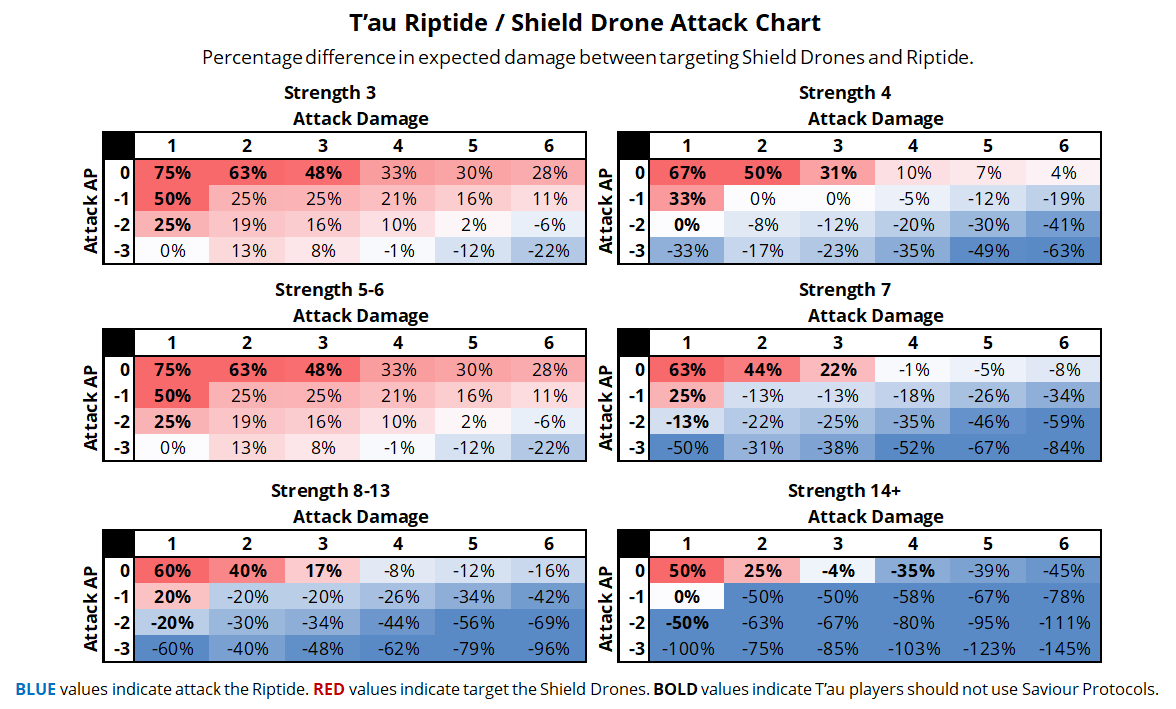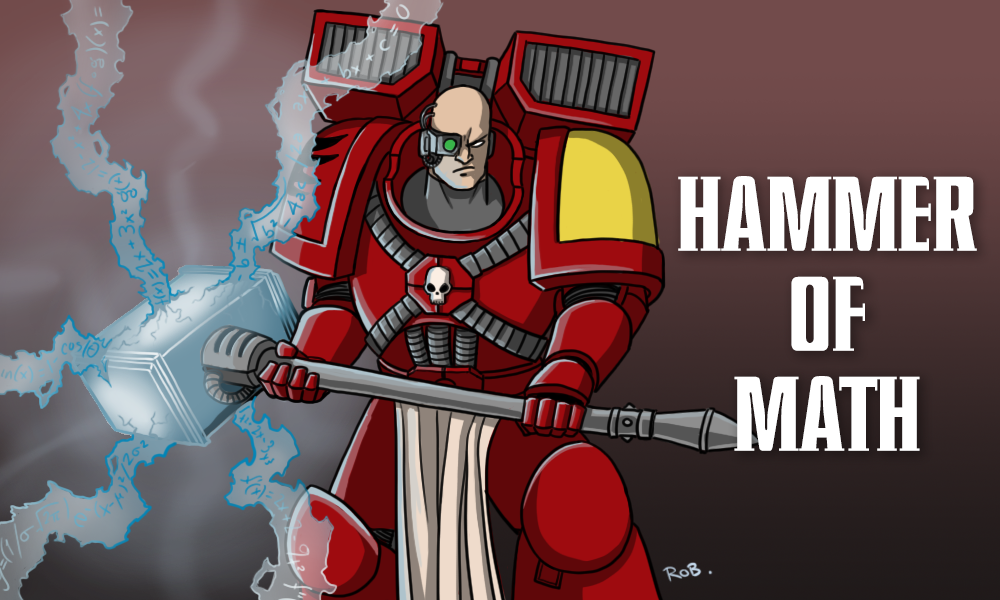Welcome back, statheads! This week we’re finishing up our T’au c’hat series by looking at a question that was repeatedly asked by non-Tau players over the last two articles: When shooting at a Riptide, should you target the battlesuit itself or the lowly drones hanging around it that provide it with ablative wounds?
We’re also continuing our new format for Hammer of Math. Rather than put together comprehensive articles, we’re going to drill down on specific questions and maintain a more concise format. If you have any ideas or questions that you’d like to see answered in a future Hammer of Math, we’d love to hear about them! We’ve put together a form for you to submit your ideas and requests. Thank you so much for reading, and we look forward to answering your questions!
Much like when we discussed the best scenarios to use Saviour Protocols, the first step in analyzing the output of an attack is to establish a goal. Are we exclusively interested in dealing wounds to the Riptide, even though the presence of the Shield Drones will dramatically reduce the damage dealt? Are we more interested in focusing entirely on the Shield Drones, even if it comes at the risk of eliminating a potential multi-damage hit on the target we actually care about? I decided to take a hybrid approach; our goal is to do as much damage as possible to everything. This allows us to weight attacks that could potentially get through and hurt the Riptide against clearing out the Shield Drones.

The Math
As with last week’s article we’re going to take an expected value approach. This allows us to easily compare several combinations to get a complete understanding of the scenario. Using a simulation approach is also possible to give the probability of killing a drone versus wounding the Riptide, but that would require several million iterations for not as much benefit.
The math here is fairly simple with three possible outcomes: The attack can be allocated to the Shield Drone, it can be allocated to the Riptide and end up being converted into single mortal wound on the Shield Drone via Saviour Protocols, or it can be allocated the Riptide either by failing the Saviour Protocols roll or the player choosing not to use the ability. This provides us with three expected values to calculate:
Targeting the Shield Drone:
EV = P(Wounding T4) x P(4++ Save) x (1 – P(5+ FNP)^D) = P(Wounding T4) x 0.5 x (1-0.667^D)
This is slightly different than the usual format because the Shield Drone is a 1-wound model, so additional damage will never increase the expected value above 1. Instead damage significantly alters the probability of wound by forcing the Shield Drone to make multiple Feel No Pain saves; one per damage dealt. Any failed test results in a dead drone. The result is an exponential function in the last term.
Saviour Protocols Allocated:
EV = P(Wounding T7) x (5/6) x (1 – P(5+ FNP)) = P(Wounding T7) x 0.556
Here the attack must still wound the Riptide, but once that happens the attack can be allocated to the Shield Drone on a 2+. The successful wound converts the attack into a single mortal wound, so 83% of the time the Damage characteristic of the attack is irrelevant. Any attack that wounds a Riptide protected by Saviour Protocols will kill a Shield Drone 56% of the time.
Wound Allocated to Riptide:
EV = P(Wounding T7) x (1/6) x P(2+ or 4++ Save) x Damage
Here we finally see where the AP of the weapon is relevant. If the T’au player chooses to ignore Saviour Protocols then the 1/6 term drops out, which is useful against threats which have a low penetration.
The Results
I ran the expected values for three scenarios; attacking the Shield Drones, attacking the Riptide and activating Saviour Protocols, and attacking the Riptide and allocating the wound to it. I looked at 191 combinations of strength (2 to 9 and 14), AP (0 to -3), and damage (1 to 6) . For purposes of this analysis I ignored the hit roll, assumed nothing had cover, and ignored edge cases such as attacks that deal mortal wounds on a particular wound or hit result. I also assumed that Nova Shield was not active and the Riptide was limited to a 5+ invulnerable save (see below for how to handle this situation). You can find the raw data in this Google Sheets document. Feel free to copy it, edit it, and see if there are any errors.

For weapons with variable damage (such as a lascannon), use the expected value for the die roll. The expected value of a single d6 is 3.5, and the expected value for a single d3 is 2. If the Riptide’s Nova Shield is active and the Riptide has a 3+ invulnerable save then you can treat all weapons with an AP value of -2 or better as having AP -1, and so use the AP-1 row of the corresponding table to figure out whether to target the drone or the riptide and whether to tank the hit.
- The variation in wound rolls between S3, S4, and S5 weapons against T4 and T7 targets heavily influences which target is optimal.
- The massive benefit of the 2+ armour save on the Riptide makes targeting the Shield Drones a preferred strategy for any AP 0 attack with a Damage characteristic of 3 or less; this also would apply to AP -1 attacks against a Riptide in cover.
- For T’au players, not using Saviour Protocols against AP 0 (AP -1 while in cover) attacks that deal 1-3 damage and 1 damage attacks with an AP characteristic of -1 or -2 (or AP -3 while in cover) will result in less total damage.
- Context is critically important, particularly in the later stages of the game where it may be more important to have a chance at killing the Riptide than killing more Shield Drones.
- Likewise for the T’au players, the decision to tank the wound on the Riptide will also depend on how many wounds you have remaining; at 2-3 wounds above a damage bracket, tanking wounds becomes more risky; at 1 wound above the next damage bracket, you are going to drop when you use the Nova Reactor anyways, so tanking the wound isn’t an issue.
Conclusions
While it would have been nice to be able to establish a perfect rubric for the optimal strategy between targeting Riptides and Shield Drones, the varying influence of the wound roll makes it difficult. We do see that low-AP, low-damage weapons are always better off targeting Shield Drones regardless of their Strength characteristic, and that those are also the kinds of weapons that the T’au player is going to see more damage reduction for when they ignore Shield Protocols and rely on the Riptide’s 2+ armour save. Obviously many of these characteristics are edge cases (I’m not aware of any faction that Games Workshop hates enough to create a S14 weapon with AP 0 that only deals 1 damage), but hopefully the chart serves as a useful reference.
If you have any comments, feel free to drop a note in the comments below or email us at contact@goonhammer.com. If you have any questions that you think would be a great topic for Hammer of Math we’d love to hear about them! We have a form set up that you can submit your questions here.


